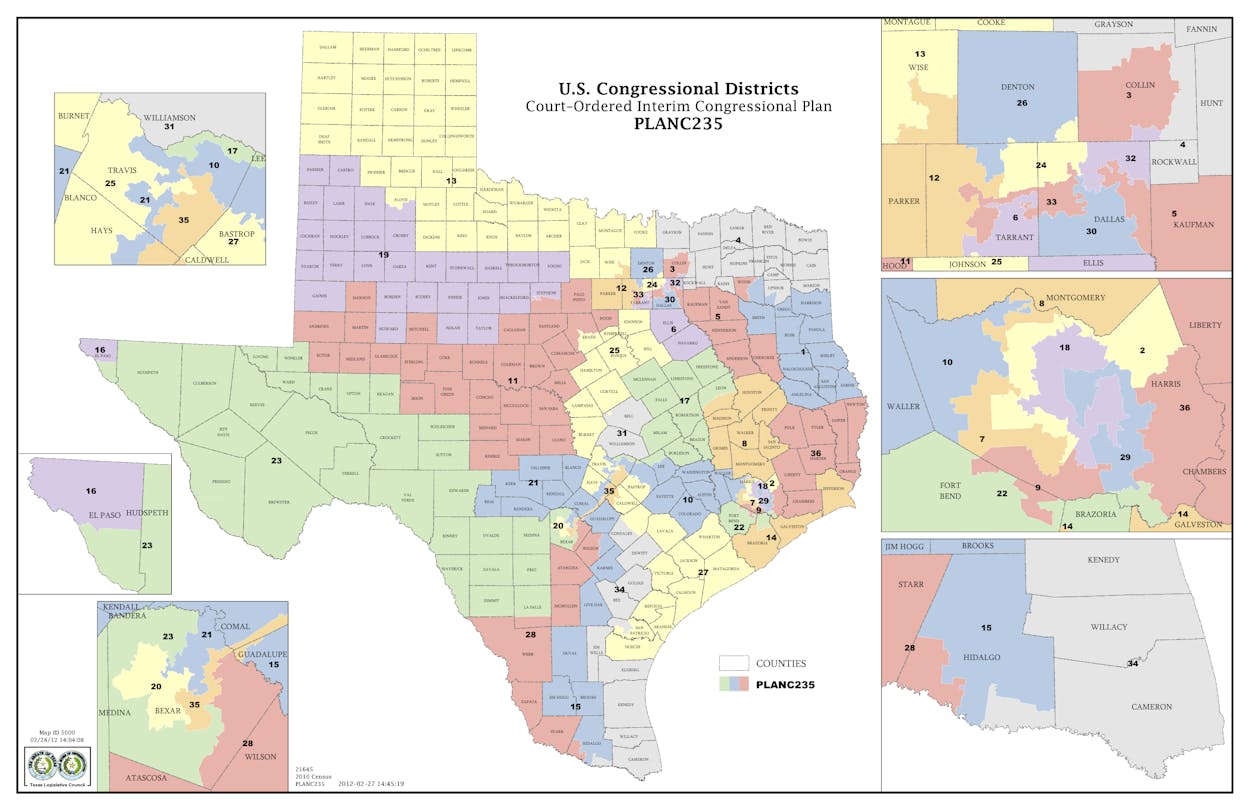Exactly seven days before the originally scheduled March 6 Texas primary, a panel of federal judges in San Antonio released its latest set of interim redistricting maps, putting the state on track for a May 29 primary.
The court’s first try was rejected by the U. S. Supreme Court as insufficiently respectful of the Republican legislature’s original attempt; since then, the court has hammered out new maps with input from both the state and the various plaintiffs who challenged the legislature’s original maps on the grounds that they do not properly represent Texas’s growing minority populations.
All the plans are still under consideration by a D.C. court, which is trying to determine if Texas redistricting violates the Voting Rights Act (for more on the implications of that case, read this Voting Rights primer from NPR). The finding from that case could reset everything again (hence the “interim”), but that’s not likely to happen this election cycle.
In the, ahem, interim, here’s what you need to know:
1. Get along, little Doggett
Nine-term Congressman Lloyd Doggett of Austin won’t have to face San Antonio state representative Joaquin Castro, who is still running for retired U.S. Representative Charlie Gonzalez’s Congressional District 20 seat. But Doggett doesn’t get to keep his (relatively) Austin-centric district either: Travis County now includes five different districts (up from three) and Doggett’s current District 25 has been redrawn into a Republican-leaning enclave that goes all the way to Tarrant County.
Doggett will now run in the San Antonio-anchored District 35, according to Tim Eaton of the Austin American-Statesman. Bexar County Tax Assessor-Collector Sylvia Romo will challenge him.
Hours before the maps came out, Doggett took to Twitter for the first time in over a month to announce a fundraiser in San Antonio, followed by his official statement in response to the new maps.
{media number=”1″ align=”block” size=”large”}{/media}
2. MALDEF is happy, LULAC is not
The Mexican American Legal Defense and Education Fund’s Nina Perales told the Statesman‘s Eaton that the new congressional map was “a plan we could live with.”
“This plan does what the Texas Legislature did not, which is increase the number of Latino-majority congressional seats,” she said.
MALDEF had been more willing to compromise on Doggett’s district than the League of United Latin American Citizens, having made a deal with Abbott several weeks ago. According to Eaton, LULAC’s Luis Vera “called the maps “a disaster” that did not increase Latino representation.”
3. The Republicans are happier than the Democrats
According to the Republican Party of Texas’s analysis:
The new State House map creates one less Republican district (defined as a district being over 50% Republican) than the map drawn by the Legislature – it is an improvement over the previous map issued by the San Antonio three-judge panel, which drew three less Republican districts.
[The new map] translates into the Republican Party expecting to gain 2 of the 4 new Congressional seats. Under the original Congressional map issued by the Legislature, the Republican Party hoped to gain 3 seats. However, we may not have gained any seats under the previous map drawn by the San Antonio three-judge panel.
And from the Democratic Party of Texas’s statement:
We appreciate the court’s efforts, but their maps are far from accurate representation. These maps may be slightly better than those passed by a radical legislature but they still grossly misrepresent the demographics of our state.
4. “Pairings” a non-issue. Ditto the Senate maps.
Ross Ramsey of the Texas Tribune noted that eight new state legislative districts “pair” current incumbents, but with the exception of Connie Scott (R-Robstown, currently District 34) and Raul Torres (R-Corpus Christi, currently District 33) most of those races involve members who are either retiring, moving, or pursuing another office (among them Warren Chisum, who is running for Railroad Commision, and Rodney Anderson, who is running for Senate).
The Senate map is almost entirely the same as the one originally drawn by the legislature, except for the restoration of Wendy Davis’s District 10, a compromise that all parties agreed to several weeks ago.
5. It could all still go to hell
How? Appeals by any of the current plaintiffs or a ruling by the D.C federal court that’s still considering specific Voting Rights Act issues could throw the whole thing off. And these latest maps still have to receive the very pre-clearance the original legislative maps have not.
But everyone from Abbott (“I believe these interim maps will be the maps used for this election cycle,” he told the Statesman‘s Eaton) to Michael Li of the Texas Redistricting blog seem to agree the May 29 election will go forward and any further changes would not be implemented until 2014.
Or 2013. As Li notes, “it remains to be seen whether the Legislature has the stomach” to take another pass at redistricting again during the next session.
- More About:
- Politics & Policy
- Redistricting
- Greg Abbott







